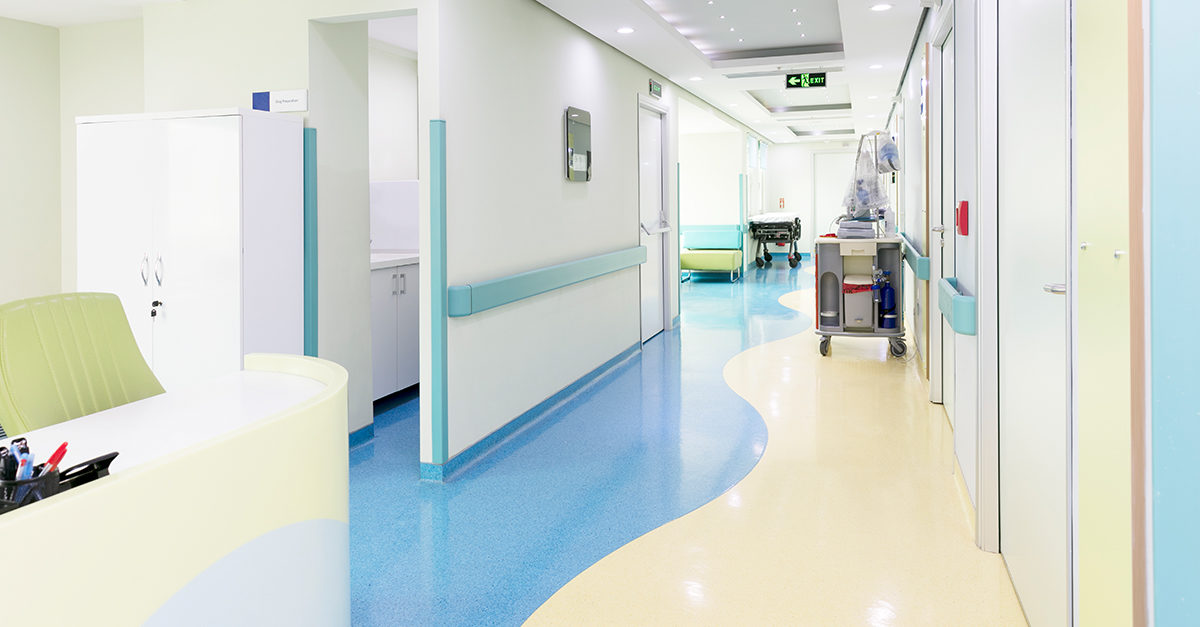It is common knowledge among environmental services (EVS) workers in hospitals and other health care facilities that door knobs, waiting room chairs, and other high-touch objects can be contaminated with germs. We are taught that handwashing and sanitizing can help reduce the transmission of bacteria and viruses. Therefore, we regularly wash our hands and disinfect high-touch surfaces. However, another transmission source is right below our feet although rarely on our minds—flooring.
Due to high foot traffic from patients, staff, and visitors, hospital floors not only experience a lot of wear and tear but they often spread unwanted pathogens. EVS staff may overlook floors when preparing a room for a new patient, leaving behind germs from previous patients and greatly increasing the risk of transmitting infection. According to the U.S. Centers for Disease Control and Prevention (CDC), one in 31 hospital patients contracts a health care-associated infection every day.
Step 1: Choose a nonporous flooring material
Bacteria mitigation within hospitals is multifaceted. Proper and regular floor maintenance are key components to successful mitigation, but choosing the correct flooring solution for the type of facility is also crucial. Flooring material can either hinder or help the spread of bacteria.
Grouted tile, vinyl, and other sectioned flooring is attractive and durable. However, bacteria can easily get trapped in the seams and grout lines, inevitably leading to pathogen proliferation. Unsealed concrete also can harbor germs. Concrete is coarse and can absorb liquids and other particles, providing an inviting environment for bacteria.
Unlike sectioned flooring or unsealed concrete, resinous floor coatings, also known as epoxies, and urethane flooring systems are seamless and impermeable. Installed as a fluid mixture, once cured they are strong, durable, and long-lasting.
These seamless flooring options can make sanitizing and general flooring maintenance easier and more effective by eliminating crevices that harbor bacteria and preventing any potential absorption of fluids.
Step 2: Utilize chemical-resistant flooring
The chemical-resistant characteristics of seamless floor coating systems help promote a sanitary health care environment. Hospitals and health care facilities often use strong cleaning chemicals to fight the spread of bacteria. Over time, these chemicals slowly deteriorate flooring. Not only can they strip away at a floor’s strength and longevity, but they can stain and discolor some flooring types.
With chemical-resistant floor coatings, a hospital can keep its flooring safe and well maintained. These coatings withstand chemicals with a high pH level and strong solvents that are a part of strict and stringent sanitizing routines.
Step 3: Clean regularly
No matter what flooring type is in place, it’s necessary to devise a comprehensive maintenance and care plan, cleaning regularly and thoroughly with effective cleaning solutions to eliminate infection risk.
Step 4: Address spills immediately
Hospitals and health care facilities are exposed to fluids every day—some of them hazardous. With surgeries, patient care, food service, and other activities, these spills are inevitable. If they are not cleaned immediately, the risk of spreading bacteria and other pathogens throughout the facility increases.
Put a plan of action in place to clean spills quickly and sanitize the affected area thoroughly. The faster the spill is addressed, the better a facility can minimize the risk of infection.
Step 5: Give your floors a health checkup
Keeping tabs on the condition of your facility’s floors is also important since they endure extreme foot and heavy-wheeled traffic. Moving heavy equipment and beds throughout the facility could potentially damage the floor over time. Do routine checks for damaged areas and if you observe cracking or peeling, promptly fix it yourself or find an appropriate contractor.
Mitigating infection is crucial to patient and worker health. With continuous hospital activity, floors can easily be overlooked and become the culprit for infections. Choosing flooring that fits your facility’s specific needs, as well as regularly cleaning and sanitizing it, can help reduce the risk of infection throughout your health care facility.



